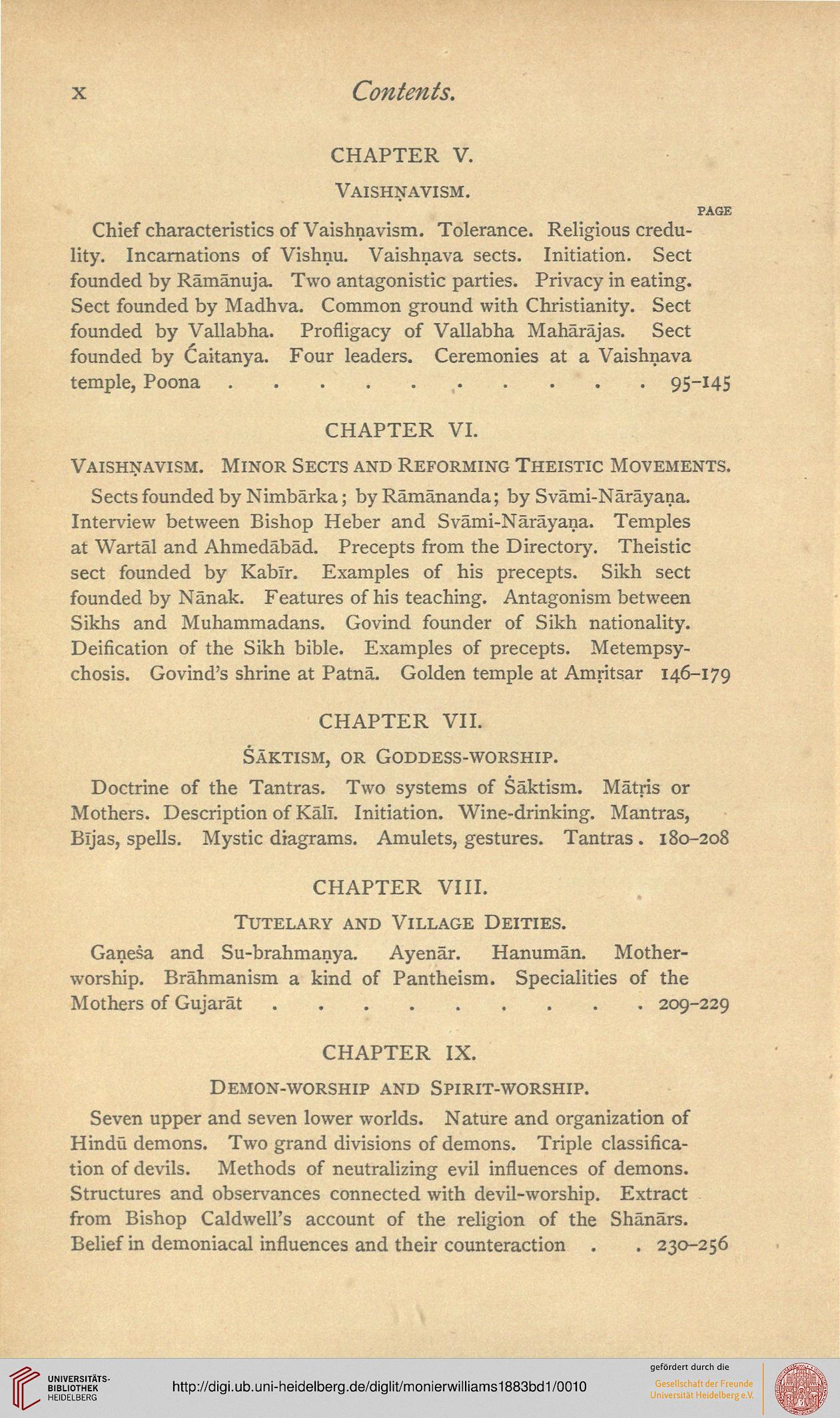x Contents.
CHAPTER V.
Vaishnavism.
PAGE
Chief characteristics of Vaishnavism. Tolerance. Religious credu-
lity. Incarnations of Vishnu. Vaishnava sects. Initiation. Sect
founded by Ramanuja. Two antagonistic parties. Privacy in eating.
Sect founded by Madhva. Common ground with Christianity. Sect
founded by Vallabha. Profligacy of Vallabha Maharajas. Sect
founded by (Saitanya. Four leaders. Ceremonies at a Vaishnava
temple, Poona.....,.....95~I45
CHAPTER VI.
Vaishnavism. Minor Sects and Reforming Theistic Movements.
Sects founded by Nimbarka; byRamananda; by Svami-Narayana.
Interview between Bishop Heber and Svami-Narayana. Temples
at Wartal and Ahmedabad. Precepts from the Directory. Theistic
sect founded by Kablr. Examples of his precepts. Sikh sect
founded by Nanak. Features of his teaching. Antagonism between
Sikhs and Muhammadans. Govind founder of Sikh nationality.
Deification of the Sikh bible. Examples of precepts. Metempsy-
chosis. Govind's shrine at Patna. Golden temple at Amritsar 146-179
CHAPTER VII.
Saktism, or Goddess-worship.
Doctrine of the Tantras. Two systems of Saktism. Matris or
Mothers. Description of Kali. Initiation. Wine-drinking. Mantras,
Bljas, spells. Mystic diagrams. Amulets, gestures. Tantras. 180-208
CHAPTER VIII.
Tutelary and Village Deities.
Ganesa and Su-brahmanya. Ayenar. Hanuman. Mother-
worship. Brahmanism a kind of Pantheism. Specialities of the
Mothers of Gujarat.........209-229
CHAPTER IX.
Demon-worship and Spirit-worship.
Seven upper and seven lower worlds. Nature and organization of
Hindu demons. Two grand divisions of demons. Triple classifica-
tion of devils. Methods of neutralizing evil influences of demons.
Structures and observances connected with devil-worship. Extract
from Bishop Caldwell's account of the religion of the Shanars.
Belief in demoniacal influences and their counteraction . . 230-256
CHAPTER V.
Vaishnavism.
PAGE
Chief characteristics of Vaishnavism. Tolerance. Religious credu-
lity. Incarnations of Vishnu. Vaishnava sects. Initiation. Sect
founded by Ramanuja. Two antagonistic parties. Privacy in eating.
Sect founded by Madhva. Common ground with Christianity. Sect
founded by Vallabha. Profligacy of Vallabha Maharajas. Sect
founded by (Saitanya. Four leaders. Ceremonies at a Vaishnava
temple, Poona.....,.....95~I45
CHAPTER VI.
Vaishnavism. Minor Sects and Reforming Theistic Movements.
Sects founded by Nimbarka; byRamananda; by Svami-Narayana.
Interview between Bishop Heber and Svami-Narayana. Temples
at Wartal and Ahmedabad. Precepts from the Directory. Theistic
sect founded by Kablr. Examples of his precepts. Sikh sect
founded by Nanak. Features of his teaching. Antagonism between
Sikhs and Muhammadans. Govind founder of Sikh nationality.
Deification of the Sikh bible. Examples of precepts. Metempsy-
chosis. Govind's shrine at Patna. Golden temple at Amritsar 146-179
CHAPTER VII.
Saktism, or Goddess-worship.
Doctrine of the Tantras. Two systems of Saktism. Matris or
Mothers. Description of Kali. Initiation. Wine-drinking. Mantras,
Bljas, spells. Mystic diagrams. Amulets, gestures. Tantras. 180-208
CHAPTER VIII.
Tutelary and Village Deities.
Ganesa and Su-brahmanya. Ayenar. Hanuman. Mother-
worship. Brahmanism a kind of Pantheism. Specialities of the
Mothers of Gujarat.........209-229
CHAPTER IX.
Demon-worship and Spirit-worship.
Seven upper and seven lower worlds. Nature and organization of
Hindu demons. Two grand divisions of demons. Triple classifica-
tion of devils. Methods of neutralizing evil influences of demons.
Structures and observances connected with devil-worship. Extract
from Bishop Caldwell's account of the religion of the Shanars.
Belief in demoniacal influences and their counteraction . . 230-256




